Bivariate-Logit-Based Severity Analysis for Motorcycle Crashes in Texas, 2017–2021
Abstract
1. Introduction
1.1. Literature Review
1.2. Economic Impact and Study Area
1.3. Scope of Study
2. Materials and Methods
3. Results and Discussion
3.1. Spatial Analysis
3.2. Bivariate Analysis
3.2.1. Environmental and Temporal Characteristics
3.2.2. Road Characteristics
3.2.3. Motorcyclist Characteristics
3.3. Logistic Regression Results
4. Conclusions
Author Contributions
Funding
Institutional Review Board Statement
Informed Consent Statement
Data Availability Statement
Conflicts of Interest
References
- Shipp, E.M.; Wunderlich, R.; Perez, M.; Ko, M.; Pant, A.; Martin, M.; Chigoy, B.; Trueblood, A. Comprehensive Analysis of Motorcycle Crashes in Texas: A Multi-Year Snapshot; Texas A&M Transportation Institute: College Station, TX, USA, 2016. [Google Scholar]
- NHTSA. Motorcycle Safety. Available online: https://www.nhtsa.gov/road-safety/motorcycles (accessed on 22 June 2022).
- Geedipally, S.R.; Turner, P.A.; Patil, S. Analysis of Motorcycle Crashes in Texas with Multinomial Logit Model. Transp. Res. Rec. 2011, 2265, 62–69. [Google Scholar] [CrossRef]
- Rezapour, M.; Molan, A.M.; Ksaibati, K. Analyzing injury severity of motorcycle at-fault crashes using decision tree and logistic regression methods. Int. J. Transp. Sci. Technol. 2020, 9, 89–99. [Google Scholar] [CrossRef]
- Haque, M.M.; Chin, H.C.; Debnath, A.K. An investigation on multi-vehicle motorcycle crashes using log-linear models. Saf. Sci. 2012, 50, 352–362. [Google Scholar] [CrossRef]
- Preusser, D.F.; Williams, A.F.; Ulmer, R.G. Analysis of fatal motorcycle crashes: Crash typing. Accid. Anal. Prev. 1995, 27, 845–851. [Google Scholar] [CrossRef]
- Rifaat, S.M.; Tay, R.; de Barros, A. Severity of motorcycle crashes in Calgary. Accid. Anal. Prev. 2012, 49, 44–49. [Google Scholar] [CrossRef] [PubMed]
- Schneider, W.H.; Savolainen, P.T.; Van Boxel, D.; Beverley, R. Examination of factors determining fault in two-vehicle motorcycle crashes. Accid. Anal. Prev. 2012, 45, 669–676. [Google Scholar] [CrossRef] [PubMed]
- Wahab, L.; Jiang, H. Severity prediction of motorcycle crashes with machine learning methods. Int. J. Crashworth. 2020, 25, 485–492. [Google Scholar] [CrossRef]
- Cunningham, J.R.; Fitzsimmons, E.J.; Dissanayake, S. An Investigation of Factors Associated with Motorcycle Crashes on Kansas’s State Highway System. In Proceedings of the Transportation Research Board 97th Annual Meeting Transportation Research Board, Washington, DC, USA, 7–11 January 2018; (No. 18–04516). Article 18–04516. Available online: https://trid.trb.org/view/1496252 (accessed on 4 June 2022).
- Kitali, A.E.; Kidando, E.; Alluri, P.; Sando, T.; Salum, J.H. Modeling severity of motorcycle crashes with Dirichlet process priors. J. Transp. Saf. Secur. 2022, 14, 24–45. [Google Scholar] [CrossRef]
- Chaudhuri, U.; Ratnapradipa, K.L.; Shen, S.; Rice, T.M.; Smith, G.A.; Zhu, M. Trends and patterns in fatal US motorcycle crashes, 2000–2016. Traffic Inj. Prev. 2019, 20, 641–647. [Google Scholar] [CrossRef]
- Schneider, W.H.; Savolainen, P.T.; Moore, D.N. Effects of Horizontal Curvature on Single-Vehicle Motorcycle Crashes along Rural Two-Lane Highways. Transp. Res. Rec. 2010, 2194, 91–98. [Google Scholar] [CrossRef]
- Xin, C.; Wang, Z.; Lee, C.; Lin, P.-S.; Chen, T.; Guo, R.; Lu, Q. Development of crash modification factors of horizontal curve design features for single-motorcycle crashes on rural two-lane highways: A matched case-control study. Accid. Anal. Prev. 2019, 123, 51–59. [Google Scholar] [CrossRef] [PubMed]
- Haque, M.M.; Chin, H.C.; Huang, H. Applying Bayesian hierarchical models to examine motorcycle crashes at signalized intersections. Accid. Anal. Prev. 2010, 42, 203–212. [Google Scholar] [CrossRef]
- Islam, M. The effect of motorcyclists’ age on injury severities in single-motorcycle crashes with unobserved heterogeneity. J. Saf. Res. 2021, 77, 125–138. [Google Scholar] [CrossRef] [PubMed]
- Jimenez, A.; Bocarejo, J.P.; Zarama, R.; Yerpez, J. A case study analysis to examine motorcycle crashes in Bogota, Colombia. J. Saf. Res. 2015, 52, 29–38. [Google Scholar] [CrossRef]
- Teoh, E.R.; Campbell, M. Role of motorcycle type in fatal motorcycle crashes. J. Saf. Res. 2010, 41, 507–512. [Google Scholar] [CrossRef] [PubMed]
- Weaver, J.L.; Miller, K.R.; Benns, M.; Harbrecht, B.G. Moped Crashes are Just as Dangerous as Motorcycle Crashes. Am. Surg. 2018, 84, 826–830. [Google Scholar] [CrossRef] [PubMed]
- Ankarath, S.; Giannoudis, P.V.; Barlow, I.; Bellamy, M.C.; Matthews, S.J.; Smith, R.M. Injury patterns associated with mortality following motorcycle crashes. Injury 2002, 33, 473–477. [Google Scholar] [CrossRef]
- Peek, C.; Braver, E.R.; Shen, H.; Kraus, J.F. Lower extremity injuries from motorcycle crashes: A common cause of preventable injury. J. Trauma 1994, 37, 358–364. [Google Scholar] [CrossRef]
- Robertson, A.; Giannoudis, P.V.; Branfoot, T.; Barlow, I.; Matthews, S.J.; Smith, R.M. Spinal Injuries in Motorcycle Crashes: Patterns and Outcomes. J. Trauma Acute Care Surg. 2002, 53, 5–8. [Google Scholar] [CrossRef]
- Clarke, J.A.; Langley, J.D. Disablement resulting from motorcycle crashes. Disabil. Rehabil. 1995, 17, 377–385. [Google Scholar] [CrossRef]
- Park, G.-J.; Shin, J.; Kim, S.-C.; Na, D.-S.; Lee, H.-J.; Kim, H.; Lee, S.-W.; In, Y.-N. Protective effect of helmet use on cervical injury in motorcycle crashes: A case–control study. Injury 2019, 50, 657–662. [Google Scholar] [CrossRef] [PubMed]
- Saunders, R.N.; Dull, M.B.; Witte, A.B.; Regan, J.M.; Davis, A.T.; Koehler, T.J.; Gibson, C.J.; Iskander, G.A.; Rodriguez, C.H.; Cohle, S.D.; et al. The danger zone: Injuries and conditions associated with immediately fatal motorcycle crashes in the state of Michigan. Am. J. Surg. 2019, 217, 552–555. [Google Scholar] [CrossRef] [PubMed]
- Haworth, N.; Debnath, A.K. How similar are two-unit bicycle and motorcycle crashes? Accid. Anal. Prev. 2013, 58, 15–25. [Google Scholar] [CrossRef]
- Villaveces, A.; Cummings, P.; Koepsell, T.D.; Rivara, F.P.; Lumley, T.; Moffat, J. Association of Alcohol-related Laws with Deaths due to Motor Vehicle and Motorcycle Crashes in the United States, 1980–1997. Am. J. Epidemiol. 2003, 157, 131–140. [Google Scholar] [CrossRef]
- Notrica, D.M.; Sayrs, L.W.; Krishna, N.; Davenport, K.P.; Jamshidi, R.; McMahon, L. Impact of helmet laws on motorcycle crash mortality rates. J. Trauma Acute Care Surg. 2020, 89, 962–970. [Google Scholar] [CrossRef]
- Norvell, D.C.; Cummings, P. Association of Helmet Use with Death in Motorcycle Crashes: A Matched-Pair Cohort Study. Am. J. Epidemiol. 2002, 156, 483–487. [Google Scholar] [CrossRef]
- Kyrychenko, S.Y.; McCartt, A.T. Florida’s Weakened Motorcycle Helmet Law: Effects on Death Rates in Motorcycle Crashes. Traffic Inj. Prev. 2006, 7, 55–60. [Google Scholar] [CrossRef]
- MacLeod, J.B.A.; DiGiacomo, J.C.; Tinkoff, G. An Evidence-Based Review: Helmet Efficacy to Reduce Head Injury and Mortality in Motorcycle Crashes: EAST Practice Management Guidelines. J. Trauma Acute Care Surg. 2010, 69, 1101–1111. [Google Scholar] [CrossRef] [PubMed]
- Truong, L.T.; Tay, R.; Nguyen, H.T.T. Relationships between Body Mass Index and Self-Reported Motorcycle Crashes in Vietnam. Sustainability 2020, 12, 1382. [Google Scholar] [CrossRef]
- Doan, H.T.N.; Hobday, M.B. Characteristics and severity of motorcycle crashes resulting in hospitalization in Ho Chi Minh City, Vietnam. Traffic Inj. Prev. 2019, 20, 732–737. [Google Scholar] [CrossRef]
- Jou, R.C.; Chao, M.C. An analysis of the novice motorcyclist crashes in Taiwan. Traffic Inj. Prev. 2022, 23, 140–145. [Google Scholar] [CrossRef]
- Lin, H.-Y.; Li, J.-S.; Pai, C.-W.; Chien, W.-C.; Huang, W.-C.; Hsu, C.-W.; Wu, C.-C.; Yu, S.-H.; Chiu, W.-T.; Lam, C. Environmental Factors Associated with Severe Motorcycle Crash Injury in University Neighborhoods: A Multicenter Study in Taiwan. Int. J. Environ. Res. Public Health 2022, 19, 10274. [Google Scholar] [CrossRef] [PubMed]
- Kasantikul, V.; Ouellet, J.V.; Smith, T.; Sirathranont, J.; Panichabhongse, V. The role of alcohol in Thailand motorcycle crashes. Accid. Anal. Prev. 2005, 37, 357–366. [Google Scholar] [CrossRef]
- Sultan, Z.; Ngadiman, N.I.; Kadir, F.D.A.; Roslan, N.F.; Moeinaddini, M. Factor analysis of motorcycle crashes in Malaysia. Plan. Malays. 2016, 4, 135–146. [Google Scholar] [CrossRef]
- Manan, M.M.A.; Várhelyi, A.; Çelik, A.K.; Hashim, H.H. Road characteristics and environment factors associated with motorcycle fatal crashes in Malaysia. IATSS Res. 2018, 42, 207–220. [Google Scholar] [CrossRef]
- Sivasankaran, S.K.; Rangam, H.; Balasubramanian, V. Investigation of factors contributing to injury severity in single vehicle motorcycle crashes in India. Int. J. Inj. Control Saf. Promot. 2021, 28, 243–254. [Google Scholar] [CrossRef]
- Rahman, M.H.; Zafri, N.M.; Akter, T.; Pervaz, S. Identification of factors influencing severity of motorcycle crashes in Dhaka, Bangladesh using binary logistic regression model. Int. J. Inj. Control Saf. Promot. 2021, 28, 141–152. [Google Scholar] [CrossRef]
- Piantini, S.; Bourdet, N.; Savino, G.; Rosalie, S.; Pierini, M.; Deck, C.; Willinger, R. Potential head injury mitigation of M-AEB in real-world motorcycle crashes. Int. J. Crashworth. 2020, 25, 591–602. [Google Scholar] [CrossRef]
- Teoh, E.R. Effectiveness of Antilock Braking Systems in Reducing Motorcycle Fatal Crash Rates. Traffic Inj. Prev. 2011, 12, 169–173. [Google Scholar] [CrossRef]
- Teoh, E.R. Motorcycle crashes potentially preventable by three crash avoidance technologies on passenger vehicles. Traffic Inj. Prev. 2018, 19, 513–517. [Google Scholar] [CrossRef]
- Wang, Z.; Lee, C.; Lin, P.-S.; Guo, R.; Xin, C.; Kolla, R.D.T.N.; Yang, R.; Vasili, A. Study on Motorcycle Safety in Negotiation with Horizontal Curves in Florida and Development of Crash Modification Factors. (No. BDV25-977–21). Article BDV25-977–21. 2018. Available online: https://trid.trb.org/view/1566777 (accessed on 3 June 2022).
- Centers for Disease Control and Prevention. Motor Vehicle Crash Deaths: Costly but Preventable. Available online: http://www.cdc.gov/motorvehiclesafety/pdf/statecosts/tx-2015costofcrashdeaths-a.pdf (accessed on 3 June 2022).
- Lawrence, B.A.; Max, W.; Miller, T.R. Costs of Injuries Resulting from Motorcycle Crashes: A Literature Review (HS-809 242). Article HS-809 242. 2003. Available online: https://trid.trb.org/view/643543 (accessed on 2 June 2022).
- Pincus, D.; Wasserstein, D.; Nathens, A.B.; Bai, Y.Q.; Redelmeier, D.A.; Wodchis, W.P. Direct medical costs of motorcycle crashes in Ontario. Can. Med. Assoc. J. 2017, 189, E1410–E1415. [Google Scholar] [CrossRef] [PubMed]
- Salih, H. Identification and Analysis of the Major Factors Contributing to Fatal Crashes in Texas. Ph.D. Thesis, The University of Texas, San Antonio, TX, USA, 2020. [Google Scholar]
- Alshatti, F. Analysis of motorcycle crashes and fatalities including the impact of distracted drivers in Texas. Ph.D. Thesis, The University of Texas, San Antonio, TX, USA, 2016. [Google Scholar]
- Environmental Systems Research Institute (ESRI). ArcGIS Pro Tool Reference. Density Toolset Concept. 2014. Available online: https://pro.arcgis.com/en/pro-app/tool-reference/spatial-analyst/how-kernel-density-works (accessed on 12 June 2020).
- Chainey, S.; Ratcliffe, J. GIS and Crime Mapping; John Wiley & Sons: Hoboken, NJ, USA, 2013. [Google Scholar]
- Silverman, B.W. Density Estimation for Statistics and Data Analysis; CRC Press: Boca Raton, FL, USA, 1986. [Google Scholar]
- Vemulapalli, S.S. GIS-based spatial and temporal analysis of aging-involved crashes in Florida. Ph.D. Thesis, The Florida State University, Tallahassee, FL, USA, 2015. [Google Scholar]
- Harirforoush, H.; Bellalite, L. A new integrated GIS-based analysis to detect hotspots: A case study of the city of Sherbrooke. Accid. Anal. Prev. 2019, 130, 62–74. [Google Scholar] [CrossRef] [PubMed]
- Young, J.; Park, P.Y. Hotzone identification with GIS-based post-network screening analysis. J. Transp. Geogr. 2014, 34, 106–120. [Google Scholar] [CrossRef]
- Plug, C.; Xia, J.C.; Caulfield, C. Spatial and temporal visualisation techniques for crash analysis. Accid. Anal. Prev. 2011, 43, 1937–1946. [Google Scholar] [CrossRef] [PubMed]
- Truong, L.; Somenahalli, S. Using GIS to Identify Pedestrian-Vehicle Crash Hot Spots and Unsafe Bus Stops. J. Public Transp. 2011, 14, 99–114. [Google Scholar] [CrossRef]
- RTA. Road Traffic Accidents in NSW—1993; Roads and Traffic Authority of NSW: Sydney, Australia, 1994. [Google Scholar]
- Geurts, K.; Wets, G.; Brijs, T.; Vanhoof, K. Identification and ranking of black spots: Sensitivity analysis. Transp. Res. Rec. J. Transp. Res. Board 2004, 1897, 34–42. [Google Scholar] [CrossRef]
- RStudio Team. RStudio: Integrated Development Environment for R. RStudio; PBC: Boston, MA, USA, 2020; Available online: http://www.rstudio.com/ (accessed on 12 June 2021).
- Billah, K.; Sharif, H.O.; Dessouky, S. Analysis of Pedestrian–Motor Vehicle Crashes in San Antonio, Texas. Sustainability 2021, 13, 6610. [Google Scholar] [CrossRef]
- Billah, K.; Sharif, H.O.; Dessouky, S. Analysis of Bicycle-Motor Vehicle Crashes in San Antonio, Texas. Int. J. Environ. Res. Public Health 2021, 18, 9220. [Google Scholar] [CrossRef]
- Yu, J.; Shacket, R.W. Drinking-driving and riding with drunk drivers among young adults: An analysis of reciprocal effects. J. Stud. Alcohol 1999, 60, 615–621. [Google Scholar] [CrossRef] [PubMed]
- Hezaveh, A.M.; Cherry, C.R. Walking under the influence of the alcohol: A case study of pedestrian crashes in Tennessee. Accid. Anal. Prev. 2018, 121, 64–70. [Google Scholar] [CrossRef]
- Billah, K.; Adegbite, Q.; Sharif, H.O.; Dessouky, S.; Simcic, L. Analysis of Intersection Traffic Safety in the City of San Antonio, 2013–2017. Sustainability 2021, 13, 5296. [Google Scholar] [CrossRef]
- Billah, K.; Sharif, H.O.; Dessouky, S. How Gender Affects Motor Vehicle Crashes: A Case Study from San Antonio, Texas. Sustainability 2022, 14, 7023. [Google Scholar] [CrossRef]
- The Dangers of Intersections for Motorcyclists. Available online: https://www.callahan-law.com/the-dangers-of-intersections-for-motorcyclists/ (accessed on 28 December 2022).
- Vargas, F.D. 5 Reasons Motorcycle Accidents Are More Common at Intersections than Other Places. Law Offices of Fernando D. Vargas. Available online: https://www.vargaslawoffice.com/5-reasons-motorcycle-accidents-are-more-common-at-intersections-than-other-places/ (accessed on 28 December 2022).
- Scopatz, R.A.; DeFisher, J.; Lyon, C.; United States Federal Highway Administration Office of Safety. Emerging Practices for Addressing Motorcycle Crashes at Intersections (FHWA-SA-18-045). 2018. Available online: https://rosap.ntl.bts.gov/view/dot/49589 (accessed on 29 June 2022).
- Federal Highway Administration. Pavement Friction Management—Safety. Available online: https://safety.fhwa.dot.gov/provencountermeasures/pavement-friction.cfm (accessed on 29 June 2022).
- City of San Antonio Public Works Department. San Antonio Severe Pedestrian Injury Areas Report 2014–2018; City of San Antonio Public Works Department: San Antonio, TX, USA, 2020. [Google Scholar]
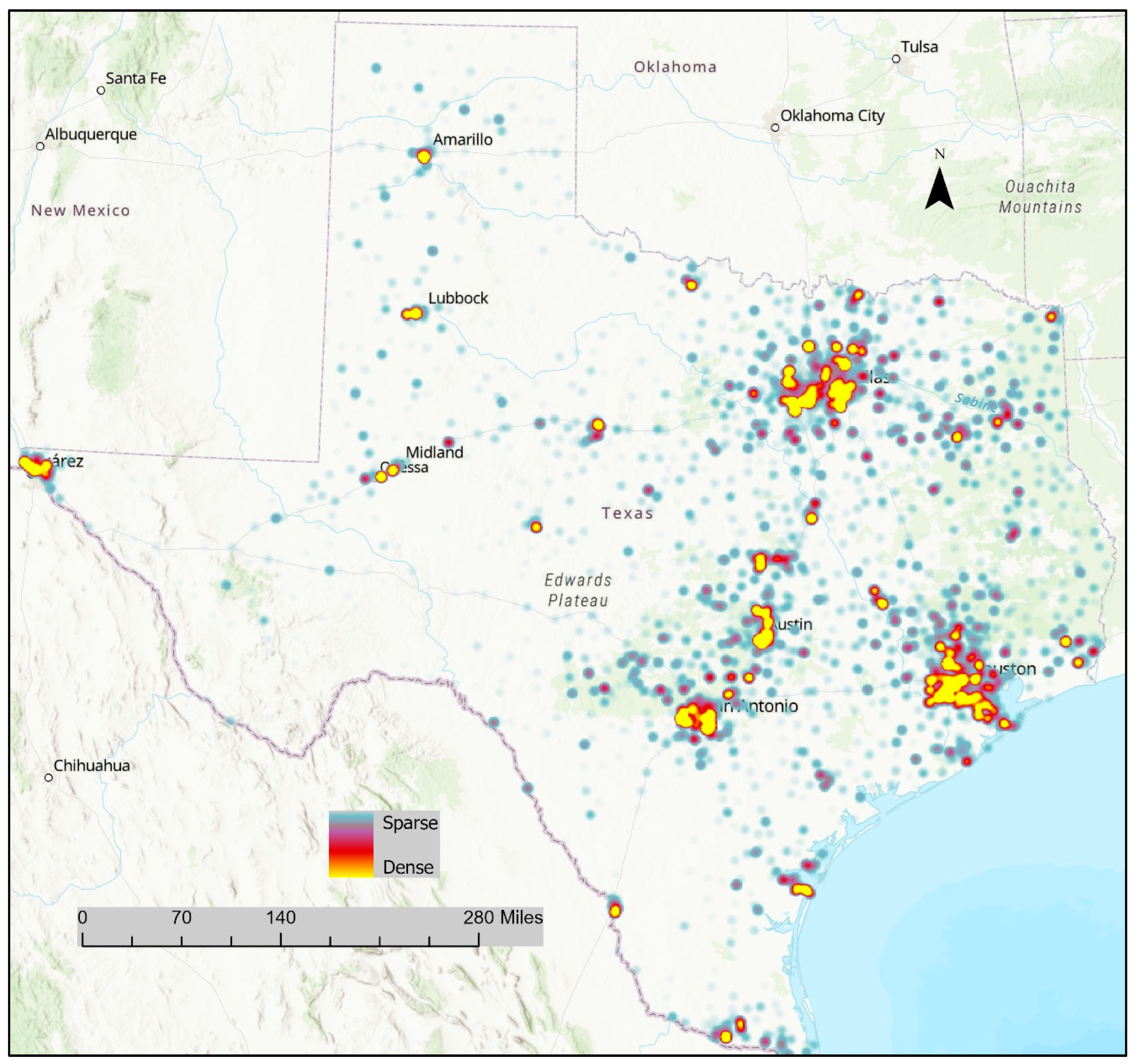
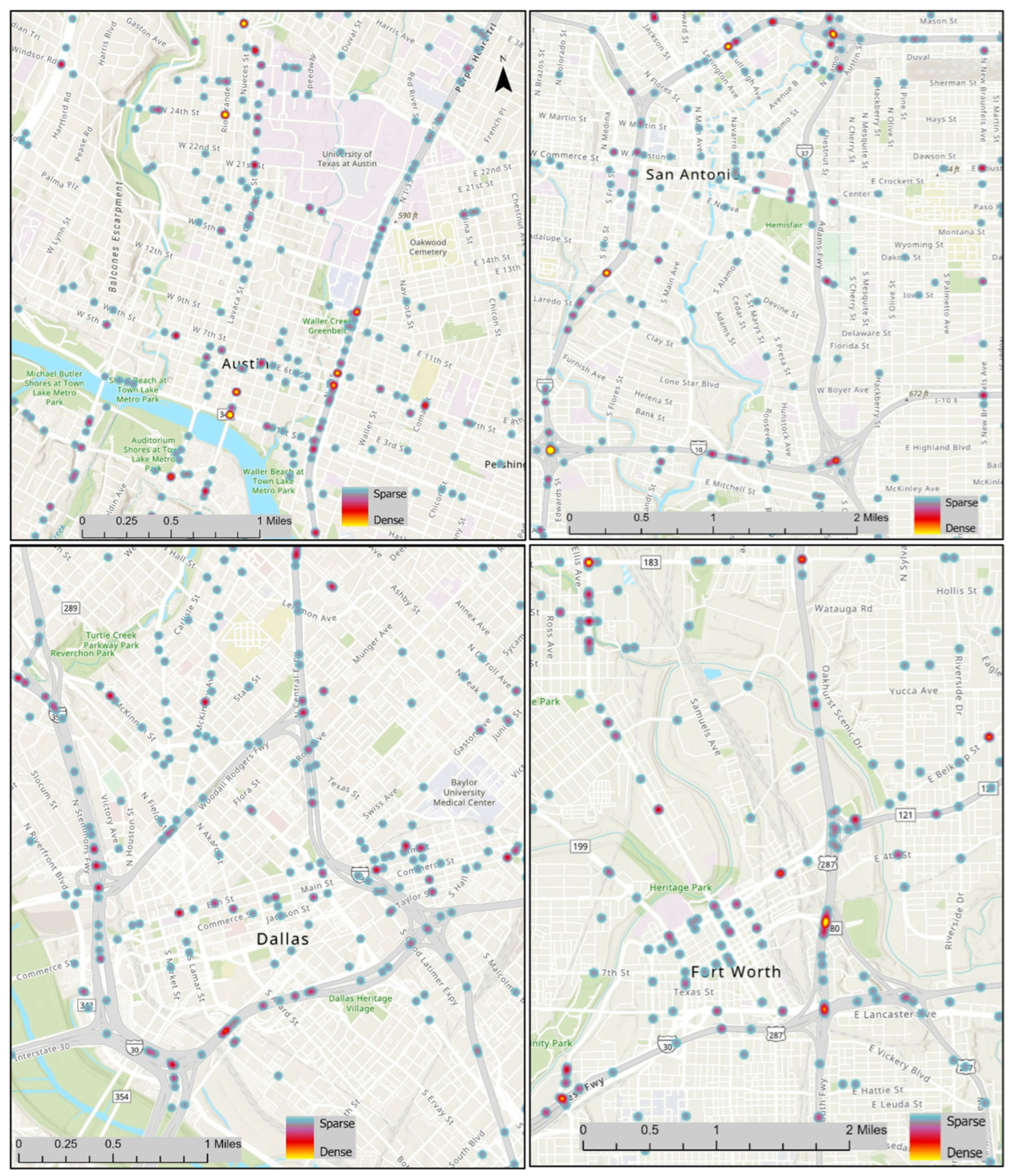
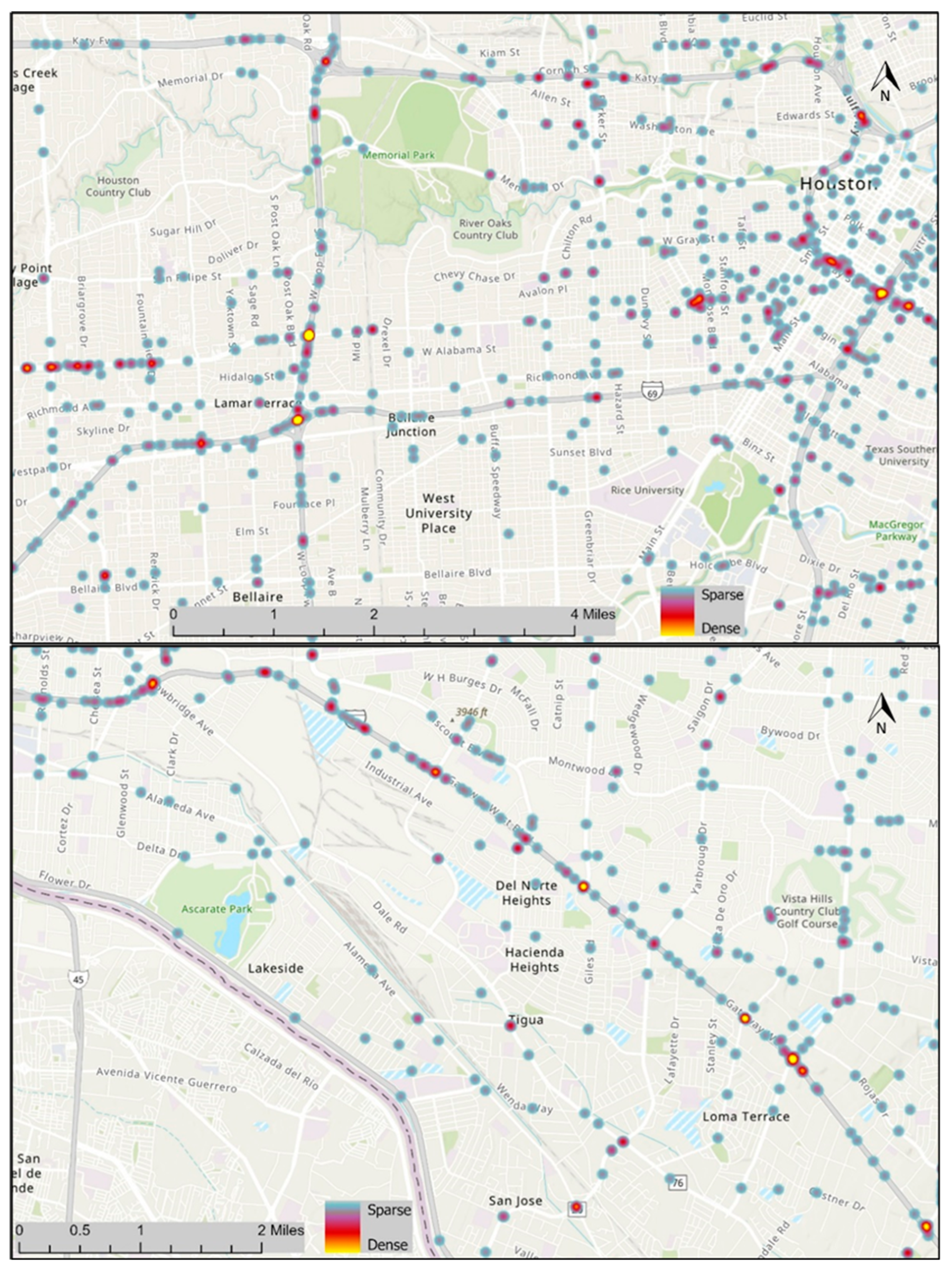
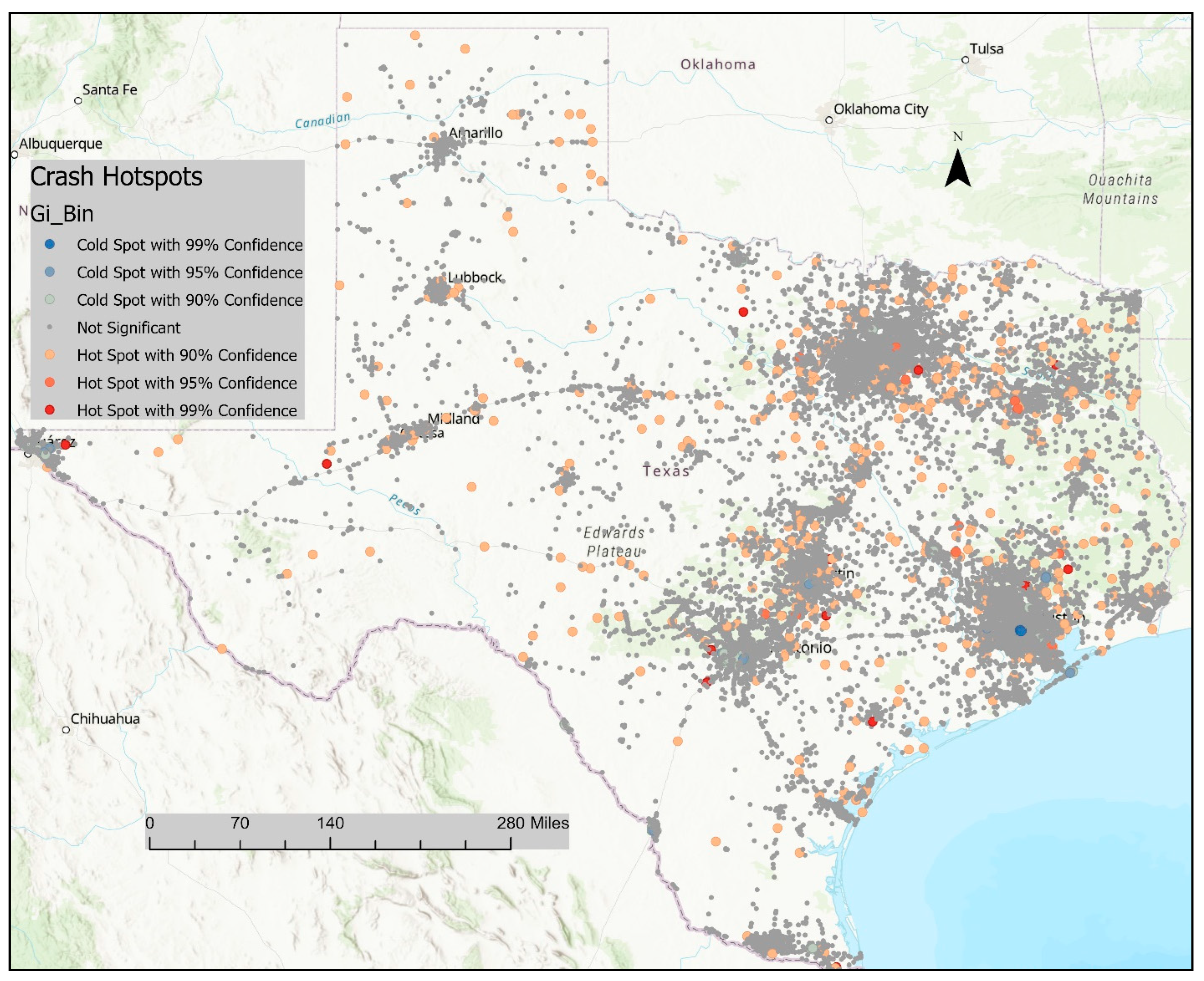
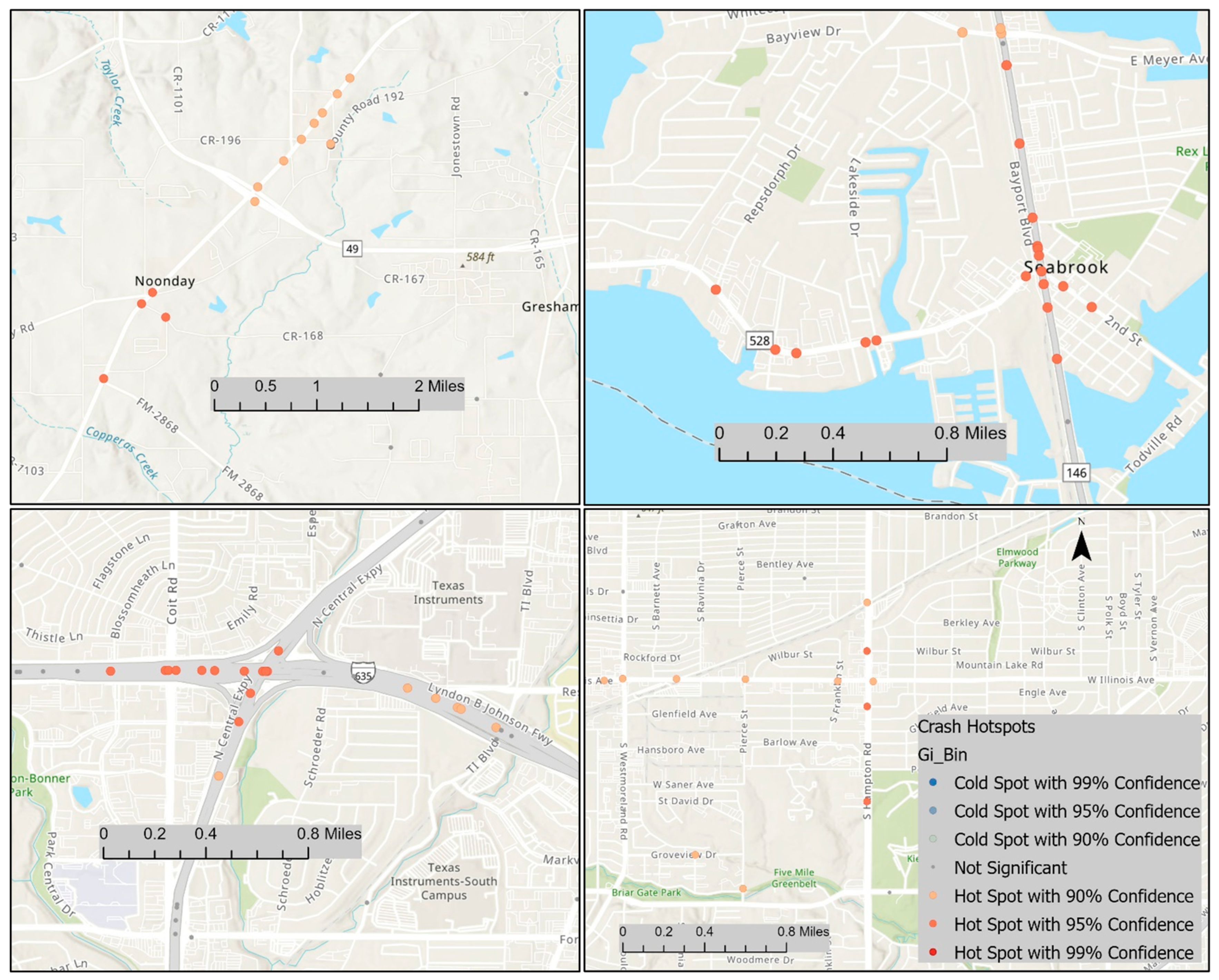
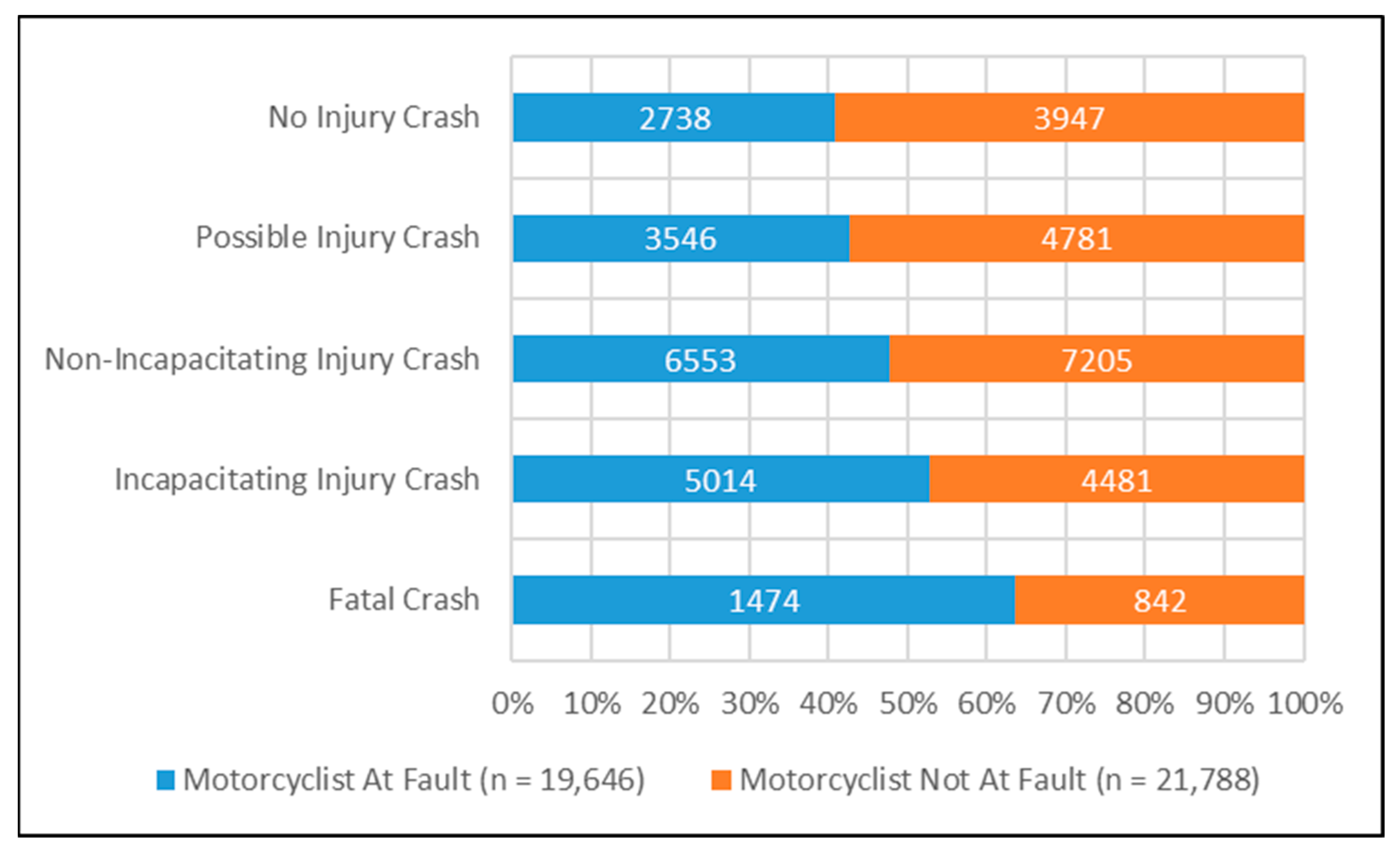
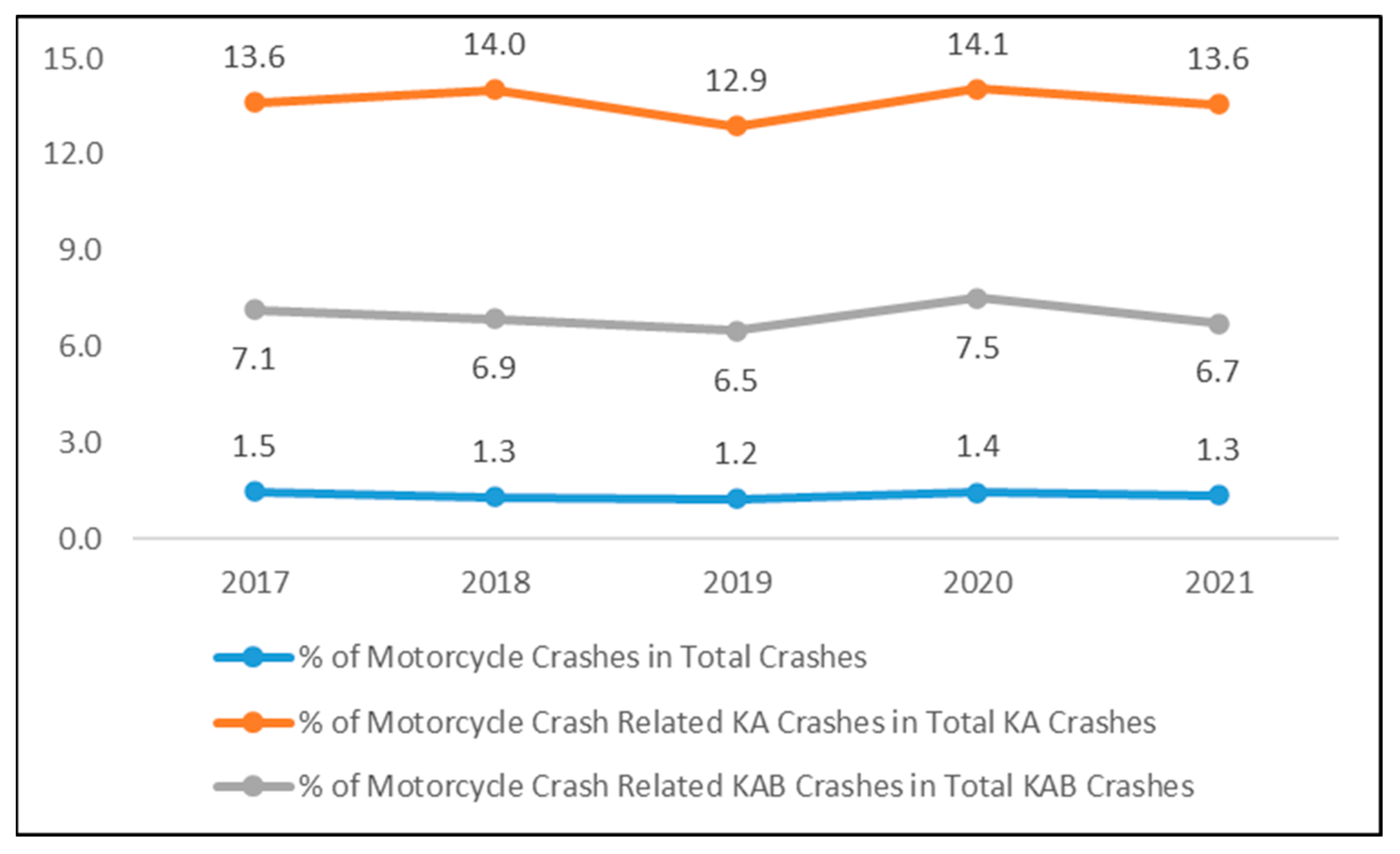
| Num. | Description | Values | Num. | Description | Values |
|---|---|---|---|---|---|
| 1 | Day of Week | Weekend | 9 | Intersection Presence | Yes |
| Weekday | No | ||||
| 2 | Speed limit | ≤25 mph | 10 | Road Class | Highway/Field to Market (FM) Road |
| >25 mph | Other Roads | ||||
| 3 | Time of Day | 8 p.m.–6 a.m. | 11 | Gender | Male |
| 6 a.m.–8 p.m. | Female | ||||
| 4 | Lighting Cond. | Daylight | 12 | Ethnicity | Hispanic |
| Dark | Non-Hispanic | ||||
| 5 | Weather Condition | Rain | 13 | Helmet Status | Worn |
| Clear/Cloudy | Not Worn | ||||
| 6 | Road Alignment | Straight/Curve (Level) | 14 | Season | Winter |
| Straight/Curve (Grade/Hillcrest) | Spring | ||||
| 7 | Traffic Control | Divider/Marked Lane | 15 | Summer | |
| Crosswalk/Stop/Signal/None | Fall | ||||
| 8 | Surface Condition | Wet | Age | ≤18 | |
| Dry | 19–64 | ||||
| ≥65 |
| All Motorcyclists | Motorcyclist at Fault | Motorcyclist not at Fault | |||||||
|---|---|---|---|---|---|---|---|---|---|
| Variable | n = 41,434 | KA% | KAB% | n = 19,646 | KA% | KAB% | n = 21,788 | KA% | KAB% |
| Lighting Condition: Daylight | 26,827 | 25.9 | 60.6 | 12,603 | 30.0 | 65.1 | 14,224 | 22.3 | 56.6 |
| Dark, not lighted | 4723 | 41.3 | 70.4 | 2461 | 45.0 | 73.1 | 2262 | 37.3 | 67.4 |
| Dark, lighted | 8520 | 29.2 | 60.6 | 3983 | 34.9 | 66.4 | 4537 | 25.3 | 55.5 |
| Weather Condition: Clear | 34,937 | 28.6 | 61.7 | 16,429 | 33.3 | 66.5 | 18,508 | 24.5 | 57.5 |
| Rain | 1122 | 19.3 | 51.6 | 576 | 21.7 | 56.1 | 546 | 16.7 | 46.9 |
| Cloudy | 5044 | 29.7 | 64.2 | 2510 | 34.0 | 67.9 | 2534 | 25.4 | 60.6 |
| Day of Week: Saturday | 8134 | 31.3 | 63.6 | 3984 | 35.8 | 68.1 | 4150 | 27.1 | 59.3 |
| Sunday | 6801 | 31.9 | 64.7 | 3557 | 37.3 | 69.4 | 3244 | 25.9 | 59.5 |
| Monday | 4613 | 26.3 | 59.7 | 2154 | 30.4 | 65.0 | 2459 | 22.7 | 55.1 |
| Tuesday | 4913 | 25.9 | 59.9 | 2239 | 30.0 | 63.6 | 2674 | 22.5 | 56.7 |
| Wednesday | 5027 | 26.5 | 59.2 | 2202 | 31.0 | 63.7 | 2825 | 23.0 | 55.7 |
| Thursday | 5401 | 26.7 | 61.5 | 2553 | 30.4 | 65.7 | 2848 | 23.3 | 57.8 |
| Friday | 6545 | 28.1 | 61.2 | 2957 | 32.2 | 66.1 | 3588 | 24.7 | 57.1 |
| Time: 8 p.m. to 6 a.m. | 11,257 | 34.5 | 65.0 | 5678 | 39.7 | 70.0 | 5579 | 29.1 | 60.0 |
| All other hours | 30,177 | 26.3 | 60.5 | 13,968 | 30.3 | 64.9 | 16,209 | 22.8 | 56.7 |
| Season: Winter | 7108 | 27.1 | 57.9 | 3271 | 32.2 | 63.1 | 3837 | 22.9 | 53.3 |
| Spring | 11,461 | 28.3 | 61.9 | 5493 | 33.1 | 66.8 | 5968 | 23.9 | 57.5 |
| Summer | 11,675 | 29.3 | 63.8 | 5560 | 33.7 | 68.6 | 6115 | 25.4 | 59.4 |
| Fall | 11,190 | 28.7 | 61.8 | 5322 | 32.8 | 65.7 | 5868 | 25.0 | 58.2 |
| All Motorcyclists | Motorcyclist at Fault | Motorcyclist Not at Fault | |||||||
|---|---|---|---|---|---|---|---|---|---|
| Variable | n = 41,434 | KA% | KAB% | n = 19,646 | KA% | KAB% | n = 21,788 | KA% | KAB% |
| Road Class: Interstate | 5316 | 28.5 | 61.6 | 2835 | 32.8 | 66.1 | 2481 | 23.6 | 56.3 |
| U.S./State Highway | 10,734 | 31.2 | 65.1 | 5119 | 33.7 | 67.8 | 5615 | 28.9 | 62.7 |
| FM Roads | 5952 | 37.0 | 69.7 | 3144 | 40.7 | 73.0 | 2808 | 32.9 | 66.0 |
| City Streets | 14,709 | 23.7 | 58.3 | 6159 | 28.2 | 62.4 | 8550 | 20.5 | 55.3 |
| Non-trafficway | 1256 | 11.2 | 33.1 | 394 | 23.6 | 58.1 | 862 | 5.6 | 21.7 |
| Surface Condition: Dry | 38,780 | 29.0 | 62.1 | 18,336 | 33.6 | 66.8 | 19,110 | 25.5 | 58.7 |
| Wet | 1970 | 21.7 | 55.6 | 1014 | 24.9 | 58.7 | 894 | 19.1 | 53.1 |
| Road Alignment: Straight, Level | 29,687 | 25.5 | 58.5 | 12,508 | 28.5 | 61.9 | 16,085 | 23.9 | 56.8 |
| Straight, Grade/Hillcrest | 4176 | 32.8 | 67.6 | 2009 | 35.6 | 71.1 | 2032 | 30.8 | 65.3 |
| Curve, Level | 4644 | 38.6 | 71.5 | 3262 | 42.9 | 74.6 | 1318 | 28.7 | 64.3 |
| Curve, Grade/Hillcrest | 2582 | 40.1 | 73.9 | 1757 | 44.7 | 77.6 | 770 | 30.7 | 66.6 |
| Traffic Control: None | 8022 | 23.9 | 56.9 | 3838 | 29.6 | 63.9 | 3647 | 19.6 | 52.2 |
| Signal Light | 4899 | 23.1 | 54.3 | 1859 | 24.7 | 57.5 | 2839 | 22.5 | 52.8 |
| Stop Sign | 3911 | 28.6 | 59.8 | 1245 | 32.8 | 62.7 | 2550 | 27.2 | 58.8 |
| Warning/Yield Sign | 847 | 34.7 | 66.5 | 531 | 44.3 | 74.4 | 300 | 18.3 | 53.7 |
| Divider/Center Stripe | 3563 | 35.7 | 68.8 | 1844 | 38.2 | 71.5 | 1665 | 33.4 | 65.8 |
| No Passing Zone | 1470 | 48.7 | 80.1 | 1012 | 49.8 | 80.2 | 456 | 46.5 | 80.0 |
| Marked Lanes | 17,474 | 28.9 | 64.0 | 8800 | 32.7 | 67.1 | 8289 | 25.4 | 61.3 |
| Speed Limit: 25 mph or less | 1178 | 15.9 | 42.8 | 490 | 23.9 | 58.8 | 688 | 10.2 | 31.4 |
| Over 25 mph | 38,087 | 29.5 | 63.0 | 18,411 | 33.6 | 66.9 | 19,676 | 25.6 | 59.3 |
| At Intersection: Yes | 11,470 | 28.5 | 59.9 | 4150 | 31.7 | 62.8 | 7320 | 26.7 | 58.3 |
| No | 29,964 | 28.5 | 62.4 | 15,496 | 33.4 | 67.4 | 14,468 | 23.3 | 57.1 |
| All Motorcyclists | Motorcyclist at Fault | Motorcyclist not at Fault | |||||||
|---|---|---|---|---|---|---|---|---|---|
| n = 68,408 | KA% | KAB% | n = 29,756 | KA% | KAB% | n = 38,652 | KA% | KAB% | |
| Gender: Male | 52,732 | 21.0 | 46.1 | 23,902 | 25.4 | 52.0 | 28,830 | 17.3 | 41.3 |
| Female | 12,345 | 5.2 | 14.5 | 4925 | 7.0 | 17.8 | 7420 | 4.0 | 12.3 |
| Age: 18 or less | 2422 | 11.1 | 31.1 | 1043 | 16.3 | 42.6 | 1379 | 7.3 | 22.4 |
| 19 to 64 | 57,333 | 18.7 | 41.6 | 25,723 | 22.9 | 47.2 | 31,610 | 15.2 | 37.1 |
| 65 or older | 4716 | 14.9 | 30.4 | 1790 | 18.8 | 38.3 | 2926 | 12.5 | 25.6 |
| Ethnicity: White | 36,706 | 21.1 | 45.8 | 16,809 | 25.4 | 51.3 | 19,897 | 17.6 | 41.2 |
| Hispanic | 15,906 | 14.0 | 32.9 | 6639 | 18.9 | 39.5 | 9267 | 10.5 | 28.3 |
| Black | 9313 | 14.5 | 34.6 | 4072 | 17.6 | 40.0 | 5241 | 12.1 | 30.3 |
| Asian | 1381 | 10.1 | 25.9 | 582 | 13.8 | 33.0 | 799 | 7.5 | 20.7 |
| Other | 1161 | 13.7 | 32.3 | 499 | 17.2 | 36.7 | 662 | 11.0 | 29.0 |
| Helmet Status: Yes | 23,040 | 25.4 | 59.9 | 10,863 | 28.3 | 63.0 | 12,177 | 22.7 | 57.3 |
| KA | KAB | ||||
|---|---|---|---|---|---|
| Factor | df | Chi-Square Statistic | OR | Chi-Square Statistic | OR |
| Lighting Condition: Daylight | 1 | 288.7 *** | 0.68 | 72.2 *** | 0.82 |
| Dark | 1.00 | 1.00 | |||
| Weather Condition: Rain | 1 | 47.9 *** | 0.59 | 50.3 *** | 0.65 |
| Clear/Cloudy | 1.00 | 1.00 | |||
| Road Class: Highway/FM Road | 1 | 29.3 *** | 1.00 | 28.9 *** | 1.00 |
| Other Roads | 0.89 | 0.89 | |||
| Speed Limit: ≤25 mph | 1 | 61.2 *** | 1.00 | 84.4 *** | 1.00 |
| >25 mph | 1.89 | 1.79 | |||
| Day of Week: Weekend | 1 | 111.0 *** | 1.27 | 63.9 *** | 1.19 |
| Weekday | 1.00 | 1.00 | |||
| Intersection Presence: Yes | 1 | 1.0 | 0.98 | 41.8 *** | 0.86 |
| No | 1.00 | 1.00 | |||
| Season: Winter | 3 | 10.3 * | 0.93 | 66.1 *** | 0.85 |
| Spring | 0.98 | 1.01 | |||
| Summer | 1.03 | 1.10 | |||
| Fall | 1.00 | 1.00 | |||
| Time of Day: 8 p.m.–6 a.m. | 1 | 304.6 *** | 1.00 | 111.1 *** | 1.00 |
| All other hours | 0.66 | 0.78 | |||
| Alignment: Straight/Curve (Level) | 1 | 188.0 *** | 0.68 | 220.5 *** | 0.65 |
| Straight/Curve (Grade/Hillcrest) | 1.00 | 1.00 | |||
| Surface Condition: Wet | 1 | 45.7 *** | 0.69 | 29.9 *** | 0.77 |
| Dry | 1.00 | 1.00 | |||
| Traffic Control: Divider/Marked Lane | 1 | 111.1 *** | 1.00 | 204.5 *** | 1.00 |
| Crosswalk/Stop/Signal/None | 0.78 | 0.74 | |||
| Gender: Male | 1 | 100.7 *** | 1.26 | 151.5 *** | 1.28 |
| Female | 1.00 | 1.00 | |||
| Age: ≤18 | 2 | 17.5 *** | 1.00 | 3.8 | 1.00 |
| 19–64 | 1.13 | 1.08 | |||
| ≥65 | 1.25 | 1.10 | |||
| Ethnicity: Non-Hispanic | 1 | 41.5 *** | 1.14 | 81.6 *** | 1.18 |
| Hispanic | 1.00 | 1.00 | |||
| Helmet Status: Worn | 1 | 292.6 *** | 0.68 | 185.1 *** | 0.74 |
| Not Worn | 1.00 | 1.00 | |||
| KA | KAB | ||||
|---|---|---|---|---|---|
| Factor | df | Chi-Square Statistic | OR | Chi-Square Statistic | OR |
| Lighting Condition: Daylight | 1 | 168.5 *** | 0.66 | 47.2 *** | 0.79 |
| Dark | 1.00 | 1.00 | |||
| Weather Condition: Rain | 1 | 34.5 *** | 0.55 | 29.6 *** | 0.63 |
| Clear/Cloudy | 1.00 | 1.00 | |||
| Road Class: Highway/FM Road | 1 | 0.2 | 1.00 | 6.4 * | 1.00 |
| Other Roads | 0.99 | 0.96 | |||
| Speed Limit: ≤25 mph | 1 | 15.8 *** | 1.00 | 7.3 ** | 1.00 |
| >25 mph | 1.54 | 1.30 | |||
| Day of Week: Weekend | 1 | 67.6 *** | 1.29 | 32.8 *** | 1.20 |
| Weekday | 1.00 | 1.00 | |||
| Intersection Presence: Yes | 1 | 5.1 * | 0.92 | 35.5 *** | 0.80 |
| No | 1.00 | 1.00 | |||
| Season: Winter | 3 | 2.5 | 0.98 | 30.6 *** | 0.90 |
| Spring | 1.01 | 1.05 | |||
| Summer | 1.05 | 1.15 | |||
| Fall | 1.00 | 1.00 | |||
| Time of Day: 8 p.m.–6 a.m. | 1 | 183.7 *** | 1.00 | 69.8 *** | 1.00 |
| All other hours | 0.64 | 0.75 | |||
| Alignment: Straight/Curve (Level) | 1 | 40.8 *** | 0.81 | 128.2 *** | 0.63 |
| Straight/Curve (Grade/Hillcrest) | 1.00 | 1.00 | |||
| Surface Condition: Wet | 1 | 31.7 *** | 0.66 | 26.4 *** | 0.71 |
| Dry | 1.00 | 1.00 | |||
| Traffic Control: Divider/Marked Lane | 1 | 31.9 *** | 1.00 | 57.5 *** | 1.00 |
| Crosswalk/Stop/Signal/None | 0.50 | 0.78 | |||
| Gender: Male | 1 | 75.5 *** | 1.35 | 133.0 *** | 1.45 |
| Female | 1.00 | 1.00 | |||
| Age: ≤18 | 2 | 12.3 ** | 1.00 | 5.7 . | 1.00 |
| 19–64 | 1.27 | 1.17 | |||
| ≥65 | 1.31 | 1.19 | |||
| Ethnicity: Non-Hispanic | 1 | 5.8 * | 1.1 | 21.7 *** | 1.15 |
| Hispanic | 1.00 | 1.00 | |||
| Helmet Status: Worn | 1 | 209.5 *** | 0.64 | 132.1 *** | 0.69 |
| Not Worn | 1.00 | 1.00 | |||
| KA | KAB | ||||
|---|---|---|---|---|---|
| Variable | df | Chi-Square Statistic | OR | Chi-Square Statistic | OR |
| Lighting Condition: Daylight | 1 | 113.7 *** | 0.70 | 27.0 *** | 0.85 |
| Dark | 1.00 | 1.00 | |||
| Weather Condition: Rain | 1 | 17.3 *** | 0.62 | 24.6 *** | 0.65 |
| Clear/Cloudy | 1.00 | 1.00 | |||
| Road Class: Highway/FM Road | 1 | 42.7 *** | 1.00 | 29.6 *** | 1.00 |
| Other Roads | 0.81 | 0.85 | |||
| Speed Limit: ≤25 mph | 1 | 47.8 *** | 1.00 | 93.6 *** | 1.00 |
| >25 mph | 2.39 | 2.31 | |||
| Day of Week: Weekend | 1 | 29.0 *** | 1.20 | 20.2 *** | 1.14 |
| Weekday | 1.00 | 1.00 | |||
| Intersection Presence: Yes | 1 | 19.2 *** | 1.16 | 0.1 | 0.99 |
| No | 1.00 | 1.00 | |||
| Season: Winter | 3 | 9.1 * | 0.89 | 35.8 *** | 0.83 |
| Spring | 0.95 | 0.98 | |||
| Summer | 1.02 | 1.06 | |||
| Fall | 1.00 | 1.00 | |||
| Time of Day: 8 p.m.–6 a.m. | 1 | 101.7 *** | 1.00 | 33.2 *** | 1.00 |
| All other hours | 0.70 | 0.83 | |||
| Alignment: Straight/Curve (Level) | 1 | 57.3 *** | 0.72 | 64.5 *** | 0.72 |
| Straight/Curve (Grade/Hillcrest) | 1.00 | 1.00 | |||
| Surface Condition: Wet | 1 | 19.8 *** | 0.69 | 9.5 ** | 0.81 |
| Dry | 1.00 | 1.00 | |||
| Traffic Control: Divider/Marked Lane | 1 | 43.5 *** | 1.00 | 113.8 *** | 1.00 |
| Crosswalk/Stop/Signal/None | 0.80 | 0.73 | |||
| Gender: Male | 1 | 20.5 *** | 1.15 | 30.0 *** | 1.16 |
| Female | 1.00 | 1.00 | |||
| Age: ≤18 | 2 | 23.9 *** | 1.00 | 1.6 | 1.00 |
| 19–64 | 1.00 | 1.02 | |||
| ≥65 | 1.23 | 1.07 | |||
| Ethnicity: Non-Hispanic | 1 | 42.7 *** | 1.20 | 50.6 *** | 1.19 |
| Hispanic | 1.00 | 1.00 | |||
| Helmet Status: Worn | 1 | 73.3 *** | 0.76 | 49.2 *** | 0.81 |
| Not Worn | 1.00 | 1.00 | |||
| All Motorcyclists | Motorcyclist at Fault | Motorcyclist not at Fault | ||||||||
|---|---|---|---|---|---|---|---|---|---|---|
| Variable | Reference | Estimates | Std Error | OR | Estimates | Std Error | OR | Estimates | Std Error | OR |
| intercept 1 | −0.70 *** | 0.11 | −0.39 ** | 0.14 | −1.14 *** | 0.16 | ||||
| Stop/Signal/ Crosswalk/None | Divider/ Marked Lane | −0.24 *** | 0.03 | 0.79 | −0.23 *** | 0.04 | 0.80 | −0.24 *** | 0.04 | 0.79 |
| Daylight | Dark | −0.23 *** | 0.05 | 0.80 | −0.23 *** | 0.07 | 0.79 | −0.25 *** | 0.06 | 0.78 |
| Rain | No−Rain | −0.34 ** | 0.12 | 0.71 | −0.36 * | 0.16 | 0.70 | 0.30 | 0.19 | 0.74 |
| Other Roads | Highway | −0.08 ** | 0.03 | 0.93 | −0.003 | 0.04 | 1.00 | −0.15 *** | 0.04 | 0.86 |
| Weekend | Weekday | 0.20 *** | 0.03 | 1.22 | 0.19 *** | 0.04 | 1.21 | 0.18 *** | 0.04 | 1.20 |
| Speed Limit > 25 | Speed Limit ≤ 25 | 0.45 *** | 0.09 | 1.56 | 0.32 * | 0.13 | 1.38 | 0.59 *** | 0.14 | 1.80 |
| Level | Grade/Hillcrest | −0.33 *** | 0.03 | 0.72 | −0.32 *** | 0.04 | 0.72 | −0.27 *** | 0.05 | 0.76 |
| Wet | Dry | −0.22 * | 0.09 | 0.80 | −0.28 * | 0.12 | 0.76 | −0.21 | 0.14 | 0.81 |
| 6 a.m.−8 p.m. | 8 p.m.−6 a.m. | −0.26 *** | 0.05 | 0.77 | −0.32 *** | 0.07 | 0.73 | −0.14 * | 0.07 | 0.87 |
| Spring | Fall | 0.01 | 0.03 | 1.01 | 0.004 | 0.05 | 1.00 | −0.01 | 0.05 | 1.01 |
| Summer | Fall | 0.03 | 0.03 | 1.04 | 0.004 | 0.05 | 1.00 | 0.07 | 0.05 | 1.08 |
| Winter | Fall | −0.03 | 0.04 | 0.97 | 0.001 | 0.05 | 1.00 | −0.07 | 0.06 | 0.93 |
| Intersection_Yes | Intersection_No | 0.17 *** | 0.03 | 1.18 | 0.07 | 0.05 | 1.07 | 0.33 *** | 0.04 | 1.39 |
| intercept 2 | −1.17 *** | 0.09 | −1.05 *** | 0.12 | −1.37 *** | 0.14 | ||||
| Male | Female | 0.18 *** | 0.05 | 1.20 | 0.24 *** | 0.07 | 1.27 | 0.13 . | 0.07 | 1.14 |
| Age 19–64 | Age ≤ 18 | 0.25 *** | 0.07 | 1.28 | 0.38 *** | 0.09 | 1.46 | 0.17 | 0.12 | 1.19 |
| Age ≥ 65 | Age ≤ 18 | 0.43 *** | 0.09 | 1.54 | 0.45 *** | 0.11 | 1.58 | 0.48 *** | 0.13 | 1.61 |
| Non−Hispanic | Hispanic | 0.18 *** | 0.03 | 1.20 | 0.10 * | 0.04 | 1.11 | 0.25 *** | 0.04 | 1.29 |
| Helmet Worn | Helmet Not Worn | −0.39 *** | 0.02 | 0.68 | −0.45 *** | 0.03 | 0.64 | −0.29 *** | 0.03 | 0.75 |
| All Motorcyclists | Motorcyclist at Fault | Motorcyclist not at Fault | ||||||||
|---|---|---|---|---|---|---|---|---|---|---|
| Variable | Reference | Estimates | Std Error | OR | Estimates | Std Error | OR | Estimates | Std Error | OR |
| intercept 1 | 0.73 *** | 0.09 | 1.20 ** | 0.13 | 0.25 * | 0.12 | ||||
| Stop/Signal/ Crosswalk/None | Divider/ Marked Lane | −0.26 *** | 0.03 | 0.77 | −0.22 *** | 0.04 | 0.81 | −0.28 *** | 0.03 | 0.75 |
| Daylight | Dark | −0.05 | 0.04 | 0.95 | −0.07 | 0.07 | 0.93 | −0.05 | 0.06 | 0.95 |
| Rain | No−Rain | −0.41 *** | 0.10 | 0.66 | −0.31 * | 0.15 | 0.73 | −0.50 *** | 0.15 | 0.60 |
| Other Roads | Highway | −0.07 ** | 0.02 | 0.94 | −0.04 | 0.04 | 0.97 | −0.09 ** | 0.03 | 0.91 |
| Weekend | Weekday | 0.14 *** | 0.02 | 1.15 | 0.15 *** | 0.04 | 1.16 | 0.12 *** | 0.03 | 1.13 |
| Speed Limit > 25 | Speed Limit ≤ 25 | 0.44 *** | 0.07 | 1.55 | 0.17 | 0.11 | 1.19 | 0.66 *** | 0.10 | 1.94 |
| Level | Grade/Hillcrest | −0.38 *** | 0.03 | 0.69 | −0.41 *** | 0.05 | 0.66 | −0.30 *** | 0.05 | 0.74 |
| Wet | Dry | −0.001 | 0.08 | 1.00 | −0.13 | 0.11 | 0.88 | 0.09 | 0.12 | 1.10 |
| 6 a.m.−8 p.m. | 8 p.m.−6 a.m. | −0.22 *** | 0.05 | 0.81 | −0.30 *** | 0.07 | 0.74 | −0.10 . | 0.06 | 0.90 |
| Spring | Fall | 0.004 | 0.03 | 1.00 | 0.02 | 0.05 | 1.02 | −0.01 | 0.04 | 0.99 |
| Summer | Fall | 0.08 * | 0.03 | 1.08 | 0.12 * | 0.05 | 1.13 | 0.05 | 0.04 | 1.05 |
| Winter | Fall | −0.14 *** | 0.04 | 0.87 | −0.11 * | 0.05 | 0.90 | −0.18 *** | 0.05 | 0.84 |
| Intersection_Yes | Intersection_No | 0.03 * | 0.03 | 1.03 | −0.05 | 0.04 | 0.95 | 0.13 *** | 0.04 | 1.14 |
| intercept 2 | 0.62 *** | 0.08 | 0.63 *** | 0.11 | 0.58 *** | 0.12 | ||||
| Male | Female | −0.02 | 0.05 | 0.99 | 0.09 | 0.07 | 1.09 | −0.10 | 0.07 | 0.91 |
| Age 19–64 | Age ≤ 18 | 0.08 | 0.07 | 1.09 | 0.23 ** | 0.09 | 1.26 | −0.02 | 0.10 | 0.98 |
| Age ≥ 65 | Age ≤ 18 | 0.18 * | 0.08 | 1.20 | 0.33 ** | 0.11 | 1.39 | 0.10 | 0.12 | 1.10 |
| Non−Hispanic | Hispanic | 0.18 *** | 0.03 | 1.20 | 0.17 *** | 0.04 | 1.18 | 0.18 *** | 0.04 | 1.20 |
| Helmet Worn | Helmet Not Worn | −0.31 *** | 0.02 | 0.73 | −0.39 *** | 0.03 | 0.68 | −0.23 *** | 0.03 | 0.79 |
Disclaimer/Publisher’s Note: The statements, opinions and data contained in all publications are solely those of the individual author(s) and contributor(s) and not of MDPI and/or the editor(s). MDPI and/or the editor(s) disclaim responsibility for any injury to people or property resulting from any ideas, methods, instructions or products referred to in the content. |
© 2023 by the authors. Licensee MDPI, Basel, Switzerland. This article is an open access article distributed under the terms and conditions of the Creative Commons Attribution (CC BY) license (https://creativecommons.org/licenses/by/4.0/).
Share and Cite
Billah, K.; Sharif, H.O.; Dessouky, S. Bivariate-Logit-Based Severity Analysis for Motorcycle Crashes in Texas, 2017–2021. Sustainability 2023, 15, 10377. https://doi.org/10.3390/su151310377
Billah K, Sharif HO, Dessouky S. Bivariate-Logit-Based Severity Analysis for Motorcycle Crashes in Texas, 2017–2021. Sustainability. 2023; 15(13):10377. https://doi.org/10.3390/su151310377
Chicago/Turabian StyleBillah, Khondoker, Hatim O. Sharif, and Samer Dessouky. 2023. "Bivariate-Logit-Based Severity Analysis for Motorcycle Crashes in Texas, 2017–2021" Sustainability 15, no. 13: 10377. https://doi.org/10.3390/su151310377
APA StyleBillah, K., Sharif, H. O., & Dessouky, S. (2023). Bivariate-Logit-Based Severity Analysis for Motorcycle Crashes in Texas, 2017–2021. Sustainability, 15(13), 10377. https://doi.org/10.3390/su151310377








